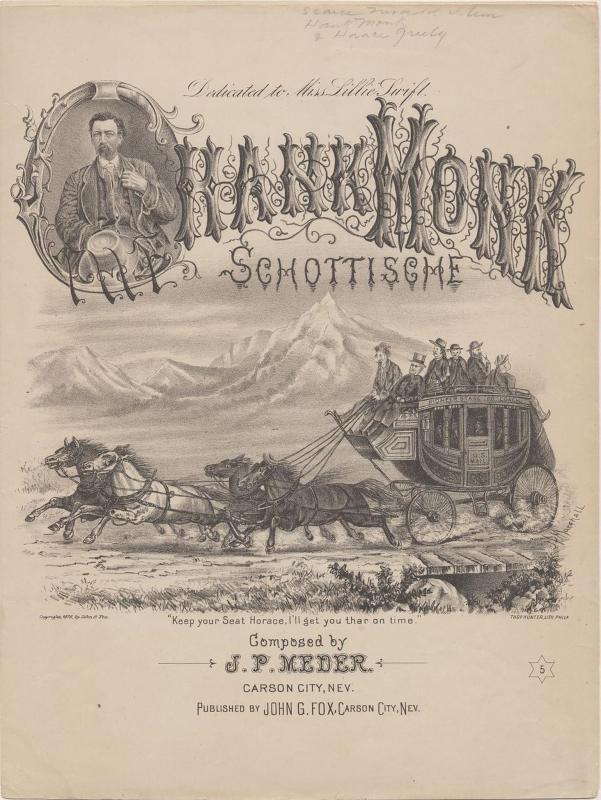Welcome to the Hank Monk Schottische Project Page
Updated: Oct. 21, 2020

Some background, by David Bugli
1. Description
The original goal of this project was to create a virtual video during the COVID-19 pandemic
involving members of the Carson City Symphony utilizing the "Hank Monk Schottische," a composition
written by Carson City Composer J.P. Meder (1848-1908). The piece was written to honor Hank Monk
(1826-1883), a legendary stagecoach driver.
Monk, who was originally from New York, was made famous in part due to a story about his giving
Horace Greeley, presidential candidate and former New York Tribune editor, a rather bumpy ride
in 1859 from Carson City to Placerville. Greeley, who was on a lecture tour, was insistent about
not being late to present a lecture in Placerville. Monk, a colorful storyteller, entertained
many people with the story of this trip and other stories about his adventures. Several reporters
and authors wrote about this famous ride; it did not portray Greeley in a favorable light.
One of those writers who picked up the story was Mark Twain (aka Samuel Clemens), who spent
a period of time with his brother, Orion, in Carson City and made his own fame in Virginia City.
Twain was so enamored of the Hank Monk story that he has several characters relate the same story
about Monk and Greeley in chapter 20 of Roughing It, Twain's 1872 book about his experience as a
young man in the western US and Hawaii. It was thought by some that the mocking of Greeley in
this story curtailed his chances of winning the Presidency of the United States.
The project features, in my mind at least, three individuals closely associated with Carson
City: Hank Monk, Mark Twain, and J.P. Meder. Ida Meacham Strobridge wrote in 1904 of Hank Monk:
Hank Monk, the incomparable! The most daring - the most reckless of drivers; and the
luckiest. The oddest, the drollest of all the whimsical characters who made Western staging
famous the world over. ... It was a dream come true! I'm quite sure that had anyone asked me
which of the two I would rather see - hear - speak to, Hank Monk, or the President (and that I
mean Abraham Lincoln), it would have been the former I unhesitantly would have chosen. Without
a doubt my youthful judgment was bias, but the fact remains."
In discussing this project during the summer of 2020, I first mentioned the idea to Carson
City Symphony musicians. I have also opened this up to musicians from the Carson Valley Pops
Orchestra, Carson High School band and orchestra players, Carson City Community Band, and Symphony
Youth Strings (STRAZZ) musicians. Additionally, having used the dance tune to accompany the Victorian
Dancers on a Carson City Symphony concert (12/15/19), I would like to see some of the dancers
performing on the video.
2. The story:
This is how Mark Twain had multiple narrators tell the story in Roughing It:
"I can tell you a most laughable thing indeed, if you would like to listen to it. Horace
Greeley went over this road once. When he was leaving Carson City he told the driver, Hank Monk,
that he had an engagement to lecture at Placerville and was very anxious to go through quick. Hank
Monk cracked his whip and started off at an awful pace. The coach bounced up and down in such a
terrific way that it jolted the buttons all off of Horace's coat, and finally shot his head clean
through the roof of the stage, and then he yelled at Hank Monk and begged him to go easier - said he
warn't in as much of a hurry as he was awhile ago. But Hank Monk said, 'Keep your seat, Horace, and
I'll get you there on time' - and you bet you he did, too, what was left of him!"
3. The tune:
The Schottische was a popular Victorian-era polka-like ballroom round dance introduced in
England in 1848, the year of J.P. Meder's birth. It was also called a German Polka, and is
thought to have originated in Bohemia. Although it has no relationship to Scotland, the music
for the dance often adopted a dotted rhythm called a "Scotch snap." In England the basic steps
were "two sidesteps to the left and right, followed by a turn in four steps," but, in the United
States, the turn was often replaced by large hopping steps, which allowed the otherwise gentile
Victorians to "accidentally" bounce into a person of the opposite gender. The "hop, skip, and jump"
pattern adopted by some dancers was well suited to the musical portrayal of the story of the bumpy
ride given to Horace Greeley.
4. The plan of the Project:
I am setting up a project resource page on the Symphony website (ccsymphony.com/hankmonk.htm).
I am revising my earlier arrangement of the "Hank Monk Schottische" for orchestra to include
additional percussion parts, sax parts, and parts for bass clarinet harp. I will have PDFs of
the parts available on the webpage. I have prepared two reference recordings, one strictly audio
and the other with video of me conducting. The video recording will be posted on the Symphony's
YouTube page (private posting available through a link I will provide).
More details can be found in the "Project Description," obtainable below.
|


